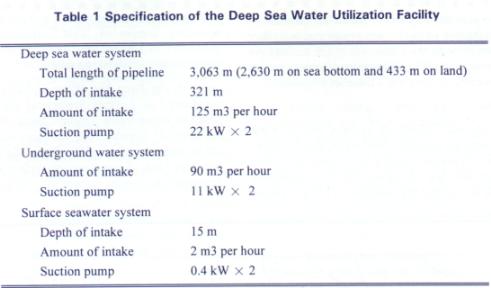BY Jun Ohtsu, Sea Farming & Deep Water Utilization Section, Toyama Prepectural Fisheries Research Institute
Abstract
In 1995, the Deep Sea Water Utilization Facility was constructed in Toyama Prefectural Fisheries Research Institute, located on the coast of Toyama Bay on the Sea of Japan. The Facility blessed with three kind of distinctive water supply; surface seawater, underground freshwater and deep seawater. The facility pumps up 125 m3 per hour of deep sea water from the depth of 321 m through a 3,063 m pipeline. The facility is provided with two high-pressure culture tanks with running deep seawater and a monitoring system. The pumped-up deep sea water is delivered into culture tanks directly, or after chilled to 0.5 ¢J by an electric chillier, or after heat-exchanged to higher temperature using surface seawater and underground freshwater.
The mean temperature of deep seawater pumped - up to the facility was 3.0¢J and its salinity was not show seasonal change.
We use deep seawater to promote the biological research and seed production of deep - sea organisms, to culture Masu salmon through the whole life cycle, to improve the seed production of shallow water species, and to apply for a variety of other non - fisheries purposes.
Introduction
The deep sea water (DSW) of Toyama Bay is stable, clean, cold and high nutrient - level water peculiar to the Sea of Japan. The main volume in Toyama Bay, joinsDSW of the Sea of Japan from geographical features. It is known that the condition of DSW is related to the movement of the warm Tsushima Current and that upwelling current of DSW influence the fisheries production in Toyama Bay. Recently, the DSW has been recognized as a natural resources.
In 1995, the Deep Sea Water Utilization Facility was constructed in Toyama Prefectural Fisheries Research Institute, Namerikawa, Toyama, Japan. It was located on the coast of Toyama Bay, the most accessible area to DSW along the coast of the Sea of Japan. The facility has three kind of water supply; surface sea water (SSW, seasonally fluctuating between 8 - 30¢J), underground freshwater (UW, 18¢J) and DSW. This supply makes it possible to promote the biological research and seed production of deep - sea organisms.
The following is a profile of the facility and the characteristics of pumped - up DSW.

Scale and ability of the facility
Figure 1 illustrates the location of Toyma Prefectural Fisheries Research Institute and DSW intake pipe. The facility pumps up 125 m3 per hour of DSW from the depth of 321 m through a 2,630 m seamless pipe on the sea bottom and 433 m on land. The specification of the facility are shown in Table 1.
Culture space of the facility, it covered 825 m2, is sectioned into three areas; one in natural temperature and the others air - conditioned area. The room temperature under 10¢J so as not to change the temperature of cultureis keep water for deep - sea organisms. The other area is controlled the to keep temperature under 20¢J.
The pumped - up DSW is delivered into culture tanks directly, or after chilled to 0.5¢J by an electric chillier, or after heat - exchanged to higher temperature using SSW and UW. The facility is provided with two high - pressure culture tanks, which could give pressure to 30 kg/cm2 with running DSW. We could use them to experimental culture the deep - sea organisms under high pressure.
The water temperature, flow rates, dissolved oxygen, room temperature, and running condition of mechanism are monitored by monitoring system. Electricity receiving equipment of 150 kVA is placed.

The characteristics of deep sea water

1. Temperature
Figure 2 shows a typical sea water temperature profile of Toyama Bay. The deep seawater portion of this profile has very little seasonal change. The temperature of the water bellow 500 m in depth was constant and the range was less than 0.1¢J. Figure 3 shows the temperature of every day DSW pumped - up to the Facility. The mean temperature of DSW,ranging from 2.8¢J to 5.9¢J, through the year is 3.0¢J. Seasonally change;were not significant,but sometime,rapd change within a few day was observed. The factors bring about the change is not known.
2. Salinity
It was stable and no seasonal change in salinity of the pumped - up deep seawater occurred as shown in figure 4. It ranged from 34.04 to 34.10. T- S diagram is shown in figure 5, the correlation between temperature and salinity was not observed.
The utilization of deep seawater :

We use DSW not only to monitor itself to promote the biological research and seed production of marine organisms which live in deep - sea or low temperature.
One of main studies is seed production of Toyama shrimp Pandalus hypsonotus. We aim at to culture for at least one year, over 50,000 young shrimp to stock to Toyama Bay.
In the study of Masu salmon Onchorhyncus masou, the purpose is to culture Masu salmon in the same pond through the whole life cycle including freshwater and marine periods plus over 1,000,000 to propagate the natural population.
To manage natural resource, biological and ecological feature of red tanner crab Chinocetes japonicus, firefly squid Watasenia scintillans, and whelk Buccinum spp. were studied using DSW. In addition, studies on the culture technology of Kelp and micro algae are being carried out by taking advantage of DSW characteristics such as coldness, nutrients and cleanliness.
Not only deep - sea organisms, the DSW is used to improve the seed production of shallow water species, and to apply for food processing, fish transportation or a variety of other non-fisheries purposes.
